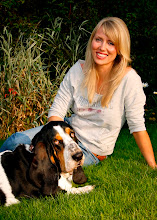Whether you’ve got a new addition to the family or have friends visiting with young children, there are ways in which you can ensure your dog bonds with a new baby. ‘Baby proofing’ your dog, is all about making your dog feel comfortable and safe. If you are expecting, then watching how your dog reacts around other children will help to give you an indication of what you can expect when your little one arrives.
A dog’s primary sense is smell – your dog is able to detect the smell of human perspiration at a concentration up to a million times lower than humans can detect! Once we understand how powerful this sense of smell is, it’s no wonder our dog shoves its nose into our shopping bags to investigate what’s in it! A baby’s going to smell fascinating to your dog – so if you’re expecting, it’s important to introduce your dog now to baby smells; allow him to explore the sweet-smelling baby products you’ll be using. When the baby is born, have a friend or family member bring home a blanket and ask them to praise your dog when he sniffs it, give him a delicious treat and allow him to smell it again. This should be repeated a number of times before the baby comes home.
Hearing is the dog’s second sense and while the cry of a newborn can make any mother nervous, it can also affect your dog. Some behaviourists suggest using a sound effects CD that includes the sounds of children and babies crying. When the CD is played at a low level, you should play with your dog and treat him to ensure he has a positive association with the noise. Also, by simply acting ‘matter of factly’ in front of the dog when your baby cries and remaining calm, will show your dog there is nothing to fear, you’re in charge and his involvement isn’t needed.
Sight is your dog’s third sense, so it’s important that your dog gets used to what a baby looks and feels like. It’s a good idea to buy a life-size baby doll and allow your dog to touch the doll’s feet with his nose; you then praise him and treat. Wrap the doll in a blanket and walk around with it in your arms, sit with the doll in one arm – as if you were feeding it and stroke your dog with the other hand. Your dog will begin to associate the close presence of your baby with good things happening to him. Use food treats to reward your dog for calm behaviour.
From the time you bring your baby home until your child is at least six to eight years of age, he or she should never be left unsupervised with any dog, no matter how well-mannered and well-trained that dog might be. Think ‘prevention is better than cure’.
More information on dogs and babies can be found on our blog petdiary.walk-the-dog.net with a great article written by Jan Fennell, The Dog Listener on ‘How to ensure your dog and baby bonds’.
skip to main |
skip to sidebar

Welcome to Walk the Dog's blog page. Walk the Dog is a pet care company in Hertfordshire, UK. Our blog gives you lots of useful information about canine behaviour, care and development, plus the latest news from WTD and our dog behaviour specalist, Hanne Grice - Dog Listener. Visit our website at www.walk-the-dog.net and our dog problems website at www.doglistener.tv
Recommended reading
Followers
Blog Archive
-
▼
2010
(35)
-
▼
January
(19)
- WTD wins Business Excellence AwardWalk the Dog has...
- Cold weather safety tips for your pets
- Dog aggression
- Understanding your cat
- Dogs and babies
- Understanding your dog - canine body language and ...
- Dog problems - Boredom Busters
- Puppies – the secret to having a happy and well be...
- Games Corner - 'Hide and Seek’
- Who's walking who? Teaching your dog to walk to heel
- Games Corner; Teach your dog to shut the door!
- A dog's sense of sight
- Rabbits & Rodents - top tips for a healthy and hap...
- Dealing with pet emergencies
- Walk the Dog Puppies - puppy classes in Hertfordshire
- Research shows misunderstanding of dogs
- Dogs and cats - can they get along?
- A dog's sense of taste
- Top tips for having a safe Christmas
-
▼
January
(19)
About Me

- Walk the Dog
- A lifetime love of animals led Hanne to start Walk the Dog. Hanne is a Highly Recommended Associate Jan Fennell Dog Listener. She is qualified in canine psychology at advanced level and canine behaviour, care and development, and holds the advanced level certifcate in Canine Communication. Walk the Dog is a multi-award winning company. Members of; JFDL, APDT, PAACT, ABS, ASAB, ABMA and NARP.
